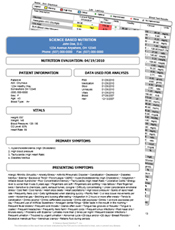The Facts
Heart disease is the leading cause of death in the United States. (1) 1 in every 4 deaths or about 600,000 people die of heart disease in the United States every year. (2) Coronary heart disease is the most common type of heart disease and costs the United States $108.9 billion each year. (3) Coronary artery disease is preventable and reversible naturally! In fact, drugs that treat hypertension and elevated cholesterol carry serious risks and do not stop heart disease from progressing. Cholesterol-lowering statin drugs are known to increase the risk of diabetes, impaired muscle function, cataracts, liver dysfunction and kidney injury. (4) The surgical interventions commonly used to treat heart disease, such as angioplasty and bypass surgery are ineffective and studies show that patients undergoing those invasive procedures do not live longer or have fewer heart attacks compared to those receiving medical therapy with modest lifestyle changes. (5)
According to the Center of Disease Control (CDC), about half (49%) of Americans with heart disease has at least one of the following these three risk factors (6):
• High blood pressure
• High LDL cholesterol
• Smoking
You cannot expect anything less if you consume the typical standard western diet consisting of fast food, processed foods, artificial sugars, and enormous portions. According to the CDC, an astonishing 80% of adults do not get the recommended amount of physical activity they need. (7) The U.S. government recommends adults get at least 2.5 hours of moderate-intensity aerobic exercise each week or one hour and 15 minutes of vigorous-intensity activity, or a combination of both. (7)
Many medical doctors including Dr. Dean Ornish, MD, founder and president of the Preventive Medicine Research Institute, along with multiple studies have shown that with significant lifestyle changes, blood flow to the heart and its ability to pump normally can improve in just weeks! (8) The heart is a muscle and just like any of the other muscles in your body, it can repair itself.
Where To Start: Blood Tests
Blood testing is a non-invasive way to determine a good starting point about your heart health. One blood test you may have not heard of is B-Type Natriuretic Peptide (BNP). BNP is secreted by the ventricles of the heart in response to excessive stretching of heart muscle cells in the ventricles. BNP is elevated in left ventricular dysfunction and correlates with both the severity of symptoms and the prognosis in congestive heart failure. BNP is a useful marker of cardiovascular risk, even in people with no clinical evidence of cardiovascular disease. The levels of BNP predict the risk of heart failure, first cardiovascular events, atrial fibrillation, and stroke or transient ischemic attack.
A study done by the Journal of the American College of Cardiology, found that BNP accurately detected heart failure 83% of the time and reduced clinical indecision from 43% to 11%. (9) Although a value closest to zero is preferred, levels over 100 suggest that heart failure is present.
Another blood test the can help determine blood flow and heart health is called International Normalized Ratio or INR. The INR is tested usually to determine the effects of oral anticoagulants, like Warfarin, on the clotting system. It basically tells us how thin or thick the blood is which can help indicate severity of circulation.
When the INR is too high it can indicate that the blood is too thin, and when the INR is too low it indicates that the blood is too thick. INR values over 4.5 increases the risk of major bleeding and an INR less than 2 increases the risk of the formation of blood clots as well as heart attack and stroke. (10)
Frequent testing at first is the key. Studies suggest that the desired results are achieved 50% of the time with monthly monitoring, compared to 85% of the time with weekly monitoring for those patients that are in a risk category or are on medications. (11)
The two blood tests mentioned above are usually not a part of your routine physical exam. However, wouldn’t it be a good idea to monitor them over time? There are other enzymes and inflammatory markers you can monitor in your blood as well such as:
• C-Reactive Protein
• Creatinine Kinase
• Cholesterol panel: HDL, VLDL, LDL, and Total Cholesterol/HDL ratio
• Triglycerides
• Hemoglobin A1C: Diabetes is profoundly linked to Cardiovascular Disease
Staying Motivated
Having a healthy heart takes motivation. The benefits of healthy dietary habits and moderate exercise need to be the number one priority. Now, although some dietary modifications need to take place, approaches that at too restrictive are not sustainable. If you slip up one day over the holidays or at a special event, don’t beat yourself up about it. Get right back on track the next day.
Most of the patients that adhere to healthier lifestyle choices are educated about it. So take the time to read labels, cook your meals at home, and never be afraid to ask questions. You will notice that when you start to make changes that these new habits will start to feel more normal. The better one feels, the more likely they will stick to it. It takes time so be patient.
It is important that you seek professional advice before making major changes to your diet, especially if you are on medications. It is never advised to stop your medications before discussing it with your doctor. By completing a comprehensive blood panel and tissue mineral analysis, you and your experienced nutritionist will be able to determine your starting point and exactly what changes need to be made.
By optimizing the body’s foundation with the correct supplements and dietary guidelines specifically designed for you based on your testing results, you can see drastic changes in just weeks. Prevention is key. So even if you feel like you don’t have heart disease symptoms, it is never too early to start monitoring. Set up your consultation today to get started on a healthier lifestyle!
References:
- Kochanek KD, Xu JQ, Murphy SL, Miniño AM, Kung HC. Deaths: final data for 2009[PDF-2M]. National vital statistics reports. 2011;60(3).
- Murphy SL, Xu JQ, Kochanek KD. Deaths: Final data for 2010. Natl Vital Stat Rep. 2013;61(4). http://www.cdc.gov/nchs/data/nvsr/nvsr61
- Heidenreich PA, Trogdon JG, Khavjou OA, et al. Forecasting the future of cardiovascular disease in the United States: a policy statement from the American Heart Association. Circulation. 2011;123:933-44. Epub 2011 Jan 24.
- Hippisley-Cox J, Coupland C: Unintended effects of statins in men and women in England and Wales: population based cohort study using the QResearch database. BMJ 2010;340:c2197.
- Boden WE, O’Rourke RA, Teo KK, et al: Optimal medical therapy with or without PCI for stable coronary disease. N Engl J Med 2007;356:1503-1516.
- CDC. Million Hearts: strategies to reduce the prevalence of leading cardiovascular disease risk factors. United States, 2011. MMWR2011;60(36):1248–51.
- Jaslow, Ryan. CDC: 80 percent of American adults don’t get recommended exercise. CBC News May 3, 2013. http://www.cbsnews.com/news/cdc-80-percent-of-american-adults-dont-get-recommended-exercise/
- Shaw, Gina. Can you reverse heart disease? http://www.webmd.com/heart-disease/features/can-you-reverse-heart-disease
- Morrison LK, Harrison A, Krishnaswamy P, et al. Utility of a rapid B-natriuretic peptide assay in differentiating congestive heart failure from lung disease in patients presenting with dyspnea. J Am Coll Cardiol 2002 Jan 16; 39(2):202-9.
- Blood Clotting: International Normalised Ratio. http://www.myvmc.com/investigations/blood-clotting-international-normalised-ratio-inr/#C2
- Horstkotte D, Piper C, Wiemer M. Optimal frequency of patient monitoring and intensity of oral anticoagulation therapy in valvular heart disease. J Thromb Thrombolysis. 1998;5(Suppl 1):19-24.


